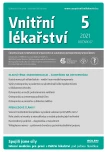Role of inflammation and imunity in atherosclerosis and possible ways of their control
Authors:
Jan Bruthans
Authors‘ workplace:
Centrum kardiovaskulární prevence 1. LF UK a Thomayerovy fakultní nemocnice, Praha
Published in:
Vnitř Lék 2021; 67(5): 304-308
Category:
Review Articles
Overview
Atherosclerosis and its clinical manifestations are characterised by ongoing arterial wall inflammation. Innate and adaptive imunity patterns are involved in all stages of atherosclerosis. Intensity of inflammation, more advanced proatherogenic imunity activity enhance development of cardiovascular (CV) disease. Efforts to control inflammation and imune proatherogenic patterns face considerable problems, but recent clinical studies offer promissing results. Statins have antiinflammatory effect, but PCSK9 monoclonal antibodies not. SGLT2 inhibitors (gliflozins) have a proven antiinflammatory effect and this might partly explain their protective CV effect. Recent clinical studies, COLCOT with colchicine and CANTOS with cinakinumab decreased inflammatory activity, CV mortality and incidence of defined CV endpoints. Other approaches to control inflammation in atherosclerosis are considered, namely blocation of proatherogenic cytokins by specific antibodies and intervention of metabolism of inflammatory cells. Vaccination against PCSK9 is being developed. Further studies may aim on active IL-1beta – IL-6 axis blocation nad on blocation of proatherogenic cytosins. Patients with signs of persistent inflammation, with specified inflammatory stage and with atherosclerotic leasion more precisely defined will be included.
Keywords:
Atherosclerosis – cardiovascular diseases – inflammation and imunity influencing – inflammation and imunity in atherosclerosis
Sources
1. Lutgens E, Atzler D, Döring Z et al. Immunotherapy for cardiovascular disease. Eur Heart J 2019; 40: 3937–3946.
2. Wolf D, Ley K. Immunity nad inflammation in atherosclerosis. Circulation Research 2019; 124: 315–327.
3. Kobiyama K, Ley K. Atherosclerosis. Circ Res 2018; 123: 1118–1120.
4. Libby P, Loscalzo J, Ridker PM et al. Inflammation, imunity, and infection in atherothrombosis: JACC review topic of the week. J Am Coll of Cardiol 2018; 72: 2071–2081.
5. Stone GW, Maehara A, Lansky AJ et al. A prospective natural-history study of coronary atherosclerosis. N Engl J Med 2011; 364: 226–235.
6. Ridker PM, Rifai N, Rose L et al. Comparison of C reactive protein and low density lipoprotein cholesterol levels in the prediction of first cardiovascular events. N Engl J Med 2002; 347: 1557–1565.
7. Lindahl B, Toss H, Siegbahn A et al. Markers of myocardial damage and inflammation in relation to long term mortality in unstable coronary disease. N Engl J Med 2000; 343: 1139–1147.
8. Koenig W. High-sensitivity C-reactive protein and atherosclerotic disease: from improved risk prediction to risk-guided therapy. Int. J Cardiol 2013; 168: 5126–5134.
9. Quispe R, Michos ED, Martin SS et al. High-sensitivity C-reactive protein discordance with atherogenic lipid measures and incidence of atherosclerotic cardiovascular disease in primary prevention: the ARIC study. J Am Heart Assoc 2020; 9: e013600. doi: 10.1161/ JAHA.119.013600.
10. Ross R. Atherosclerosis – aninflammatory disease. N Engl J Med 1999; 340: 115–126.
11. Horton JD, Goldstein JL, Brown MS. SREBPs: activators of the complete program of cholesterol and fatty acid synthesis in the liver. J Clin Invest. 2002; 109: 1125–1131.
12. Gurcel L, Abrami L, Girardin S et al. Caspase-1 activation of lipid metabolic pathways in response to bacterial pore-forming toxins promotes cell survival. Cell 2006; 126: 1134–1145.
13. Antonopoulos AS, Margaritis M, Lee R et al. Statins as anti-inflammatory agents in atherogenesis: molekular rmechanisms and lessons from the recent clinical trials. Curr Pharm Des 2012; 18: 1519–1530.
14. Sahebkar A, Giosia PD, Stamerra CA et al. Effect of monoclonal antibodies to PCSK9 on high sensitivity C-reactive protein levels: a metaanalysis of 16 randomised controlled treatment arms. Br J Clin Pharmacol 2016; 81(6): 1175–1190.
15. Cao YX, Li S, Liu HH, Li JJ. Impact of PCSK9 monoclonal antibodies on circulating hs-CRP levels: a systematic review and meta analysis of randomised controlled trials.
16. Tardif JC, Kouz S, Waters DD et al. Efficacy and safety of low-dose kolchicine after myocardial infarction. N Engl J Med 2019; 381: 2497–2505.
17. Nidorf SM, Fiolet ATL, Mosterd A. Colchicine in patients with chronic coronary disease. N Engl J Med 2020; 383: 1838–1847.
18. Ridker PM, Everett BM, Pradhan A et al. Low-dose methotrexate for the prevention of atherosclerotic events. N Engl J Med 2019; 380: 752–762.
19. Ridker PM, Everett BM, Thuren T et al. Antiinflamatory therapy with canakinumab for atherosclerotic disease. N Engl J Med 2017; 377: 1119–1131.
20. Abraham M, Wald H, Vanzel-Ohayon D et al. Development of novel promiscuous anti-chemokine peptibodies for treating autoimmunity and inflammation. Front Immunol Frontiers 2017; 8: 1432.
21. Hundelshausen von P, Agten SM, Eckardt V et al. Chemokine interactome mapping enables tailored intervention in acute and chronic inflammation. Sci Transl Med 2017; 9: eaah6650.
22. O´Neill LAJ, Kishton RJ, Rathmell J. A guide to immunometabolism for immunologist. Nat Rev Immunol 2016; 16: 553–565.
23. Mancini SJ, Boyd D, Katwan OJ et al. Canagliflozin inhibits interleukin-1beta-stimulated cytokine and chemokine secretion in vascular endothelial cells by AMP-activated protein kinase-dependent and –independent mechanism. Sci Rep 2018; 8(1): 5276.
24. Chackerian B, Remaley A. Vaccine strategies for lowering LDL by immunization against proprotein invertase subtilisin/kexin type 9. Curr Opin Lipidol 2016; 27: 345–350.
25. Piepoli MF, Hoes AW, Agewall S et al. 2016 European Guidelines on cardiovascular disease prevention in clinical practice: The Sixth Joint Task Force of the European Society of Cardiology and Other Societies on Cardiovascular Disease Prevention in Clinical Practice. Eur Heart J 2016; 37: 2315–2381.
26. Emerging Risk Factors Collaboration, Kaptoge S, Di Angelantonio E, Pennells L et al. C-reactive protein, fibrinogen, and cardiovascular disease prediction. N Engl J Med 2012; 367: 1310–1320.
Labels
Diabetology Endocrinology Internal medicineArticle was published in
Internal Medicine

2021 Issue 5
Most read in this issue
- Osteoporosis in premenopausal women
- Uncommon thrombotic complications after SARS-CoV-2 vaccination
- Osteoporosis in men: underappreciated and undertreated
- Carcinoid syndroma – diagnosis and management
